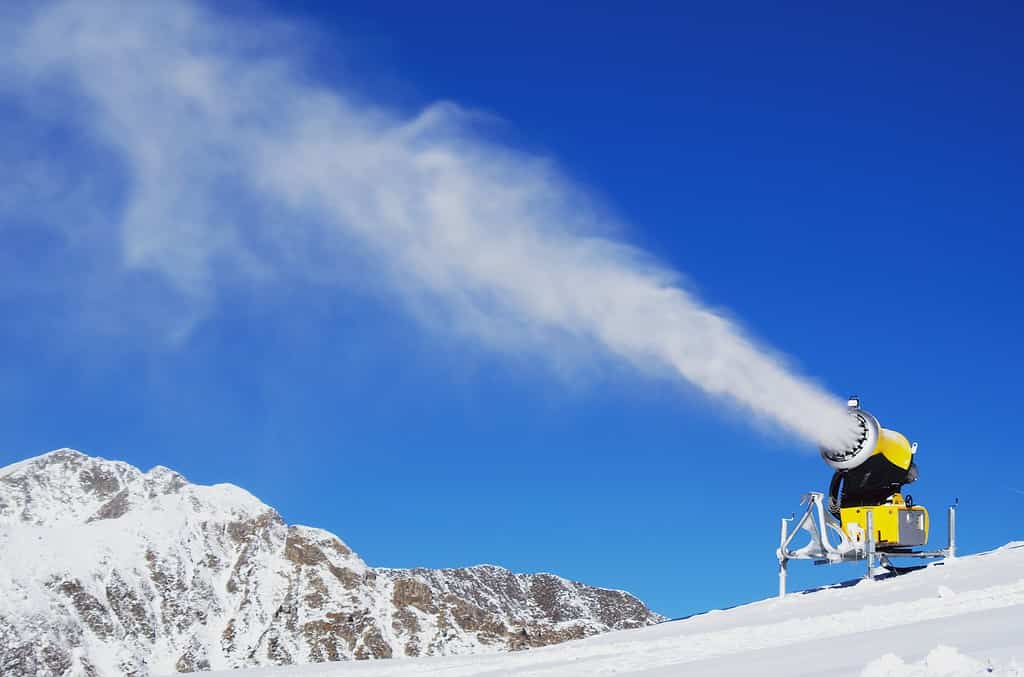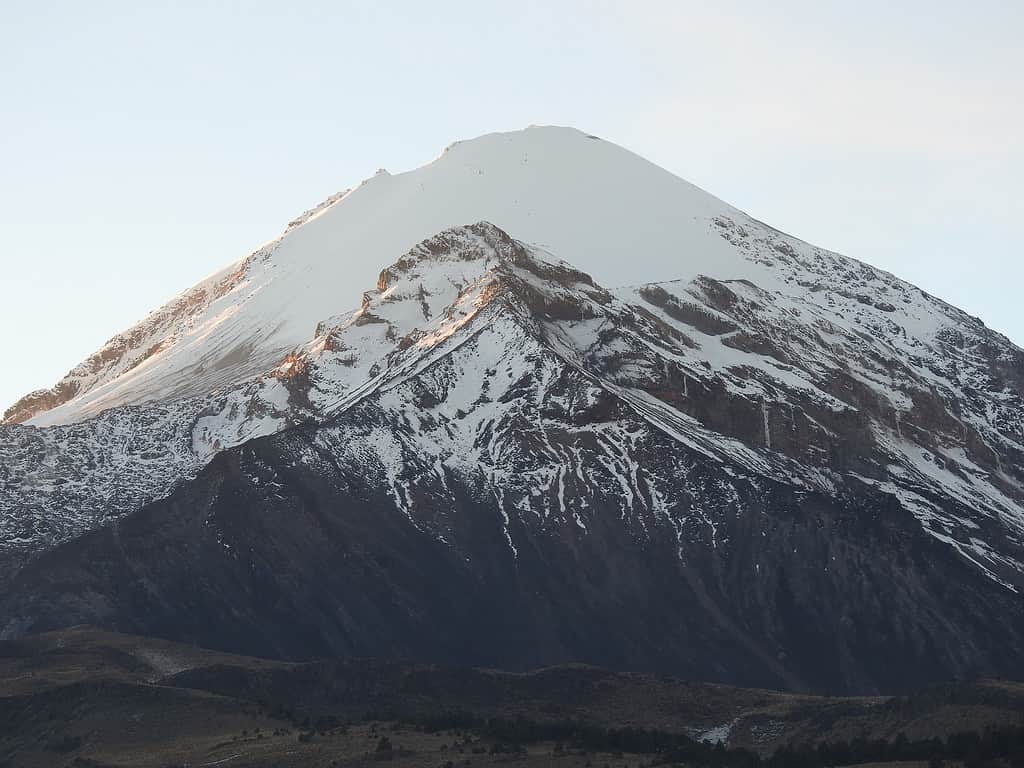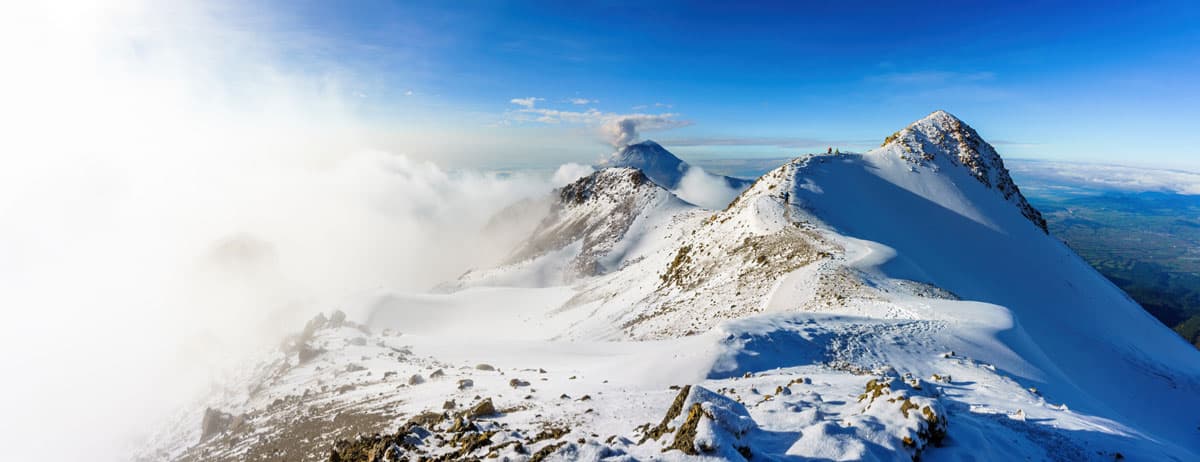Does it snow in Mexico? Yes! Though it seems unlikely, Mexico does experience snowfall. While higher elevations, such as the mountainous regions surrounding Mexico City, have occasional snow, the lower elevations enjoy a milder climate. Cities and regions at lower altitudes, including popular coastal destinations, continue to enjoy balmy temperatures, even as snow accumulates in the mountains! So, where are the snowiest places in Mexico, and what are the average amounts of snow they receive? Lace up your snow boots and don your parka as we trek through the snowy peaks of Mexico.

High elevations, such as the mountainous regions surrounding Mexico City, have occasional snow.
©iStock.com/NAILOTL
Does It Snow in Mexico? Snowiest Places
Mexico is not usually associated with heavy snowfall, but there are a few high-altitude areas where snowfall occurs. Pico de Orizaba, also called Citlaltépetl, is the highest mountain in Mexico and the third highest in North America. It is a dormant volcano located on the border between the states of Puebla and Veracruz. Due to its elevation of 18,000 feet (5,636 m), Pico de Orizaba experiences snowfall. Cofre de Perote is a volcano located near the city of Xalapa in the state of Veracruz in eastern Mexico. Cofre de Perote, or Nauhcampatépetl, is another mountainous area where snowfall is not uncommon during the winter.
The fourth highest peak in Mexico, Nevado de Toluca, is often covered with snow during the winter months. The elevation of this stratovolcano reaches over 15,000 feet (4,570 m). La Malinche, also known as Matlalcueyetl, is a dormant volcano located in the states of Puebla and Tlaxcala. With an elevation of over 14,600 feet (4,445 m), it experiences snowfall at higher elevations during colder months.

Due to its elevation of 18,000 feet (5,636 m), Pico de Orizaba is snowcapped year-round.
©nyker/Shutterstock.com
Does It Snow Enough to Ski in Mexico?
It is possible to go snow skiing in Mexico! While Mexico has only one traditional ski resort, opportunities for backcountry skiing and snowboarding are abundant. Bosques de Monterreal, located near San Antonio de las Alazanas in the state of Coahuila, is a mountain resort providing breathtaking backdrops and outdoor recreational activities. Bosques de Monterreal is one of the few places in Mexico where you can experience the winter sports of skiing and snowboarding. During the winter, the resort supplements natural snowfall with the help of a snow-making machine. The rest of the year, Bosques de Monterreal has a dry slope, with artificial turf designed to simulate the sliding sensation of snow. The dry slope allows for skiing or snowboarding year-round without the need for natural snow.

Bosques de Monterreal supplements natural snowfall with the help of a snow-making machine.
©Gherzak/Shutterstock.com
Beyond groomed trails and dry slopes, Mexico has ample opportunities to ski off the beaten path. Nevado de Toluca, despite not having a dedicated ski resort, provides opportunities for backcountry skiing and snowboarding when it receives sufficient snowfall.
Pico de Orizaba also provides opportunities for snow sports, especially on the slopes of the volcano. The mountain is snow-capped year-round thanks to the Jamapa Glacier, the last remaining of nine glaciers that originally topped Pico de Orizaba. Jamapa, on the northeastern side, is a popular destination for thrill-seeking skiers. To ski down Jamapa, one must first scale it. This entails a rigorous hike during which skiers must carry their gear. These activities are not suitable for novices or the faint of heart. Backcountry adventures are best left to experienced, adventurous skiers.

To ski down Jamapa one must first scale it. This entails a rigorous hike while carrying your skis.
©jkdber19/Shutterstock.com
Does It Snow in Mexico? Average Amounts
Average snowfall can exhibit significant variability from year to year. Natural climate phenomena, such as El Niño and La Niña atmospheric circulation patterns, contribute to the fluctuation of snowfall amounts. Climate change also affects snowfall patterns, leading to shifts in their timing, frequency, and intensity.
On the way-above-average side, we have the unlikely snow event that transpired in Mexico City in 1967. On January 12, 1967, Mexico City experienced a significant snowfall, covering the city with 3 inches (7.62 cm) of snow. Though emergency personnel were caught off-guard, the snowfall was particularly memorable for the residents of Mexico City, who experienced joy and wonder. Since records have been kept, this is the only instance in which measurable snowfall blanketed the city.
Snowfall in the mountains is more consistent, though it can vary markedly from year to year.
To learn how average snowfall in Mexico compares to snowfall in other parts of the world, check out the chart below:
| Place | Average Annual Snowfall |
|---|---|
| Chamonix, France | 400 inches (1016 cm) |
| Alyeska, Alaska, USA | 396 inches (1006 cm) |
| Aomori, Japan | 312 inches (792.5 cm) |
| Lake Louise, Banff, Canada | 196 inches (498 cm) |
| Syracuse, New York, USA | 124 inches (315 cm) |
| Denver Colorado, USA | 56.5 inches (143.5 cm) |
| Arteaga, Coahuila, Mexico | 0.3 inches (0.7 cm) |
| Shreveport, Louisiana, USA | 0.2 inches (0.5 cm) |
| Bermuda, British Territory, North Atlantic Ocean | 0.1 inches (0.25 cm) |
Thank you for reading! Have some feedback for us? Contact the AZ Animals editorial team.








